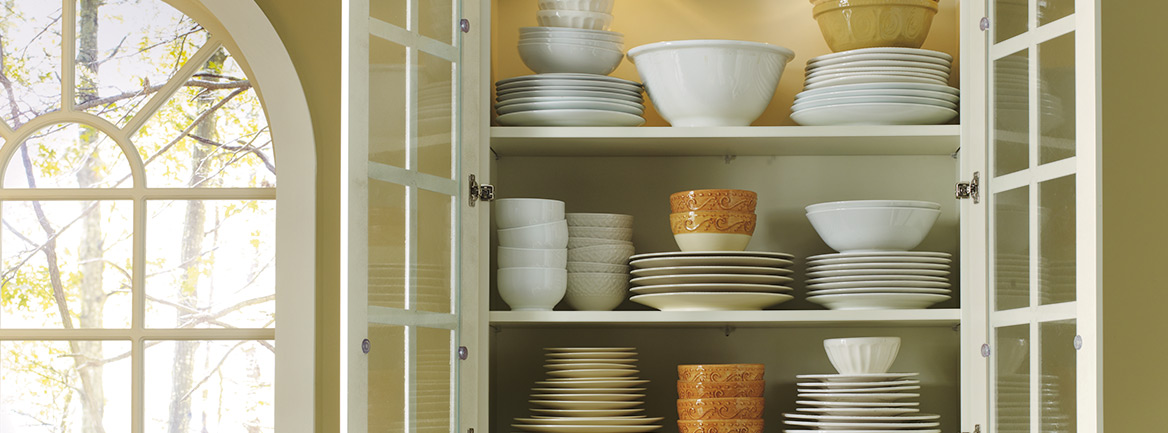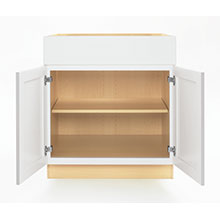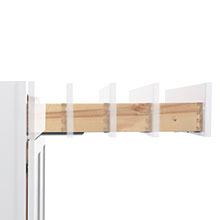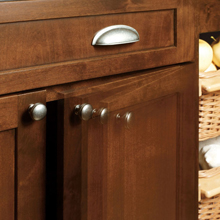
Cabinet Construction
History-Made Modern Engineering
A beautiful, functioning cabinet starts with smart construction. The following overview provides an outline of general cabinet terms and cabinet construction options. Your designer will be able to answer specific questions about which options are available.
*Most, but not all, cabinet doors, drawers, roll trays and pullouts feature our Smart Stop™ closing mechanism. Consult your Kemper designer to identify if there are exceptions in your cabinet order.
Unmatched Strength and Access with Our Load-Bearing Back
Kemper's hefty ⅜" thick load-bearing back panel extends the entire width and height of our box, providing unwavering structural support for the life of the cabinet. Because of this unique cabinet construction method, in cabinets up to 36" wide, there is no obstructing center divider like other cabinet brands.

Standard Cabinet
- ⅜" thick furniture thick board top and bottom
- ½” Thick furniture board sides
- ⅜" Thick furniture board back
- Matching laminate sides
- Natural Maple laminate wall cabinet top and bottom
- Unfinished back
- Natural Maple laminate cabinet interior
- ⅜" Thick furniture board I-beam braces
- ¾” Thick furniture board with Natural Maple laminate and PVC edgebanding adjustable shelf
- Unfinished furniture board toekick required

Plywood Upgrade Options
Kemper materials start with high-quality furniture board, a choice material commonly used throughout the cabinet industry, as standard. However, when plywood is desired, Kemper offers various options that meet your budget and project requirements.
- Plywood Ends option (PE) for unfinished veneer plywood cabinet sides
- All Plywood Construction option (APC), for unfinished veneer plywood sides as well as plywood tops, bottoms, back and adjustable shelves for highest quality craftsmanship.
- Natural Maple laminate interiors are standard with PE and APC.

Standard Drawer
- Smart Stop™ IHC drawer system allowing for easy access and self-closing*
- Integrated hydraulic cylinder (IHC) providing a noticeably smoother close
- Full extension, undermount guides with fast-clip removal system
- 4-sided, clear-coated, solid wood dovetail drawer box with laminated plywood bottom

Standard Door
- Smart Stop™ integrated door system providing gentle, controlled self-closing feature that engages when the door is near the cabinet face frame*
- Mechanism can be turned off with a flip of a switch

Standard Roll Trays
- Smart Stop™ roll tray system allowing for easy access and self-closing*
- Full extension, undermount guides with fast-clip removal system
- 4-sided, clear-coated, solid wood roll tray box
- 5/8" nominal thick dovetail sides with 5.22 mm laminated plywood bottom

Standard Pull-outs
- Smart Stop™ Guides standard on pullouts: Base and Desk Waste Basket, Base Recycling Center, Base Pantry Pullout, and Base Box Column Pullout
- Smart Stop™ on pullouts allow for easy access and self-closing*
- Full extension guides

Our Framed Cabinets
Framed is the more traditional construction type, with rails and stiles forming a “frame” at the front of the cabinet box. Framed cabinets attach door hinges to frame face and wall shelves are usually adjustable. Partial, and full overlay door styles can be used with framed cabinets.

Engineered Wood Materials
Some cabinets utilize various wood materials to provide strength, durability and consistent quality.
- Particleboard/Furniture Board – Board made from a mixture of real wood shavings and binding material, such as resin, which are refined and bonded together, then compressed with high heat and pressure
- Plywood – A panel made from an odd number of veneer layers in combination of lumber core, particleboard, MDF core and hardboard core joined with an adhesive. The grain of each layer runs at right angles to the next. All plywood components meet ANSI/HPVA HP-1 standards, and may contain MDF or particleboard.
- Medium Density Fiberboard (MDF) – Formed by breaking down hardwood or softwood residuals into wood fibers. Heat and pressure are used to form a homogenous board excellent for machining and painting.
- Thermofoil – PVC (polyvinyl chloride) foil pressed onto a MDF core using a heated, flexible membrane

Door Details
- Raised panel - The center panel of the door is elevated
- Recessed or Flat Panel – The center panel of the door is set lower
- Full Overlay – The door of the cabinet overlays (or covers) the entire face frame
- Partial Overlay – The door of the cabinet only partially overlays, leaving part of the matching frame exposed



